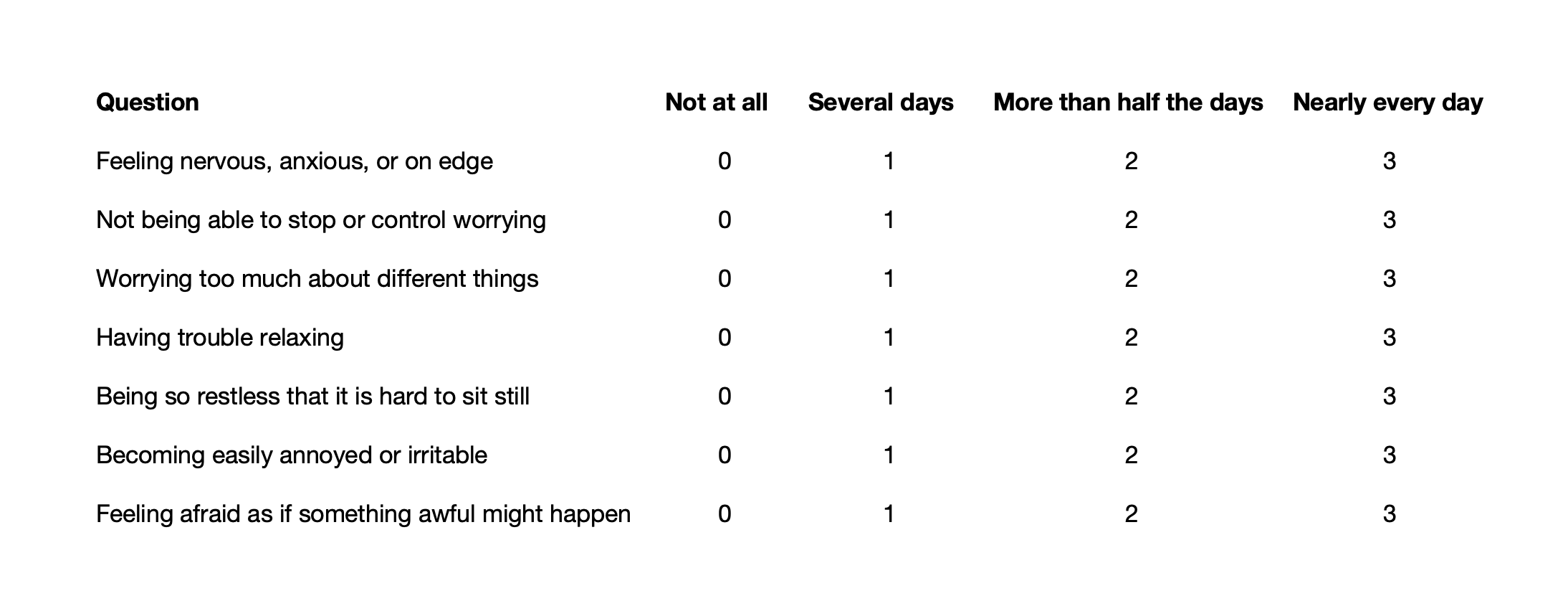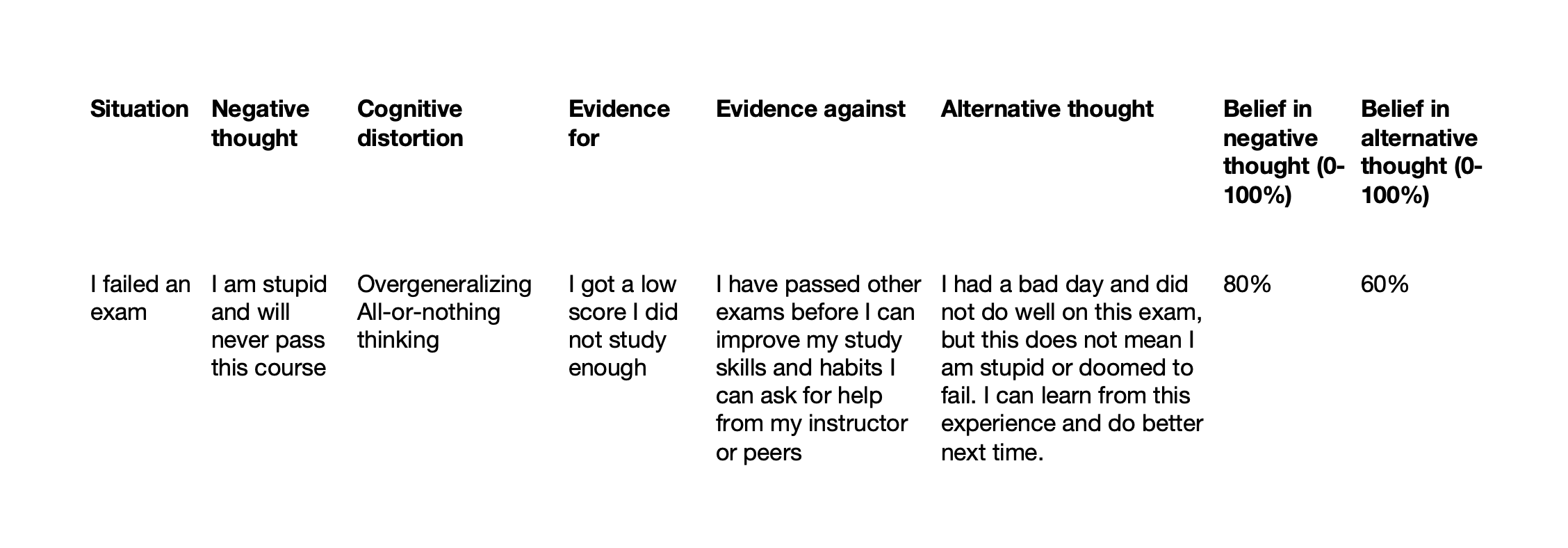Generalized Anxiety Disorder
Learn everything you need to know about Generalized Anxiety Disorder (GAD), a common and treatable mental health condition that causes excessive worry and nervousness.

Generalized anxiety disorder (GAD) is a common and chronic mental health condition that affects millions of people worldwide. People with GAD experience excessive and persistent worry and nervousness about various aspects of their lives, such as work, school, health, family, finances, or the future. They often have trouble controlling their anxiety and may feel restless, irritable, fatigued, tense, or have difficulty sleeping or concentrating. GAD can interfere with daily functioning and cause significant distress and impairment.
In this article, I will provide an overview of GAD, including its symptoms, causes, diagnosis, and treatment options. I will also discuss some strategies for coping with GAD and managing anxiety in everyday situations. My goal is to help you understand GAD better and provide you with some useful information and resources.
What are the symptoms of Generalized Anxiety Disorder?
According to the Diagnostic and Statistical Manual of Mental Disorders (DSM), the diagnostic criteria for Generalized Anxiety Disorder is as follows:
A. Excessive anxiety and worry (apprehensive expectation), occurring more days than not for at least 6 months, about a number of events or activities (such as work or school performance).
B. The individual finds it difficult to control the worry.
C. The anxiety and worry are associated with three (or more) of the following six symptoms (with at least some symptoms having been present for more days than not for the past 6 months):
Note: Only one item is required in children.
- Restlessness or feeling keyed up or on edge.
- Being easily fatigued.
- Difficulty concentrating or mind going blank.
- Irritability.
- Muscle tension
- Sleep disturbance (difficulty falling or staying asleep, or restless, unsatisfying sleep)
D. The anxiety, worry, or physical symptoms cause clinically significant distress or impairment in social, occupational, or other important areas of functioning.
E. The disturbance is not attributable to the physiological effects of a substance (e.g., a drug of abuse, a medication) or another medical condition (e.g., hyperthyroidism).
F. The disturbance is not better explained by another mental disorder (e.g., anxiety or worry about having panic attacks in panic disorder, negative evaluation in social anxiety disorder [social phobia], contamination or other obsessions in obsessive-compulsive disorder, separation from attachment figures in separation anxiety disorder, reminders of traumatic events in posttraumatic stress disorder, gaining weight in anorexia nervosa, physical complaints in somatic symptom disorder, perceived appearance flaws in body dysmorphic disorder, having a serious illness in illness anxiety disorder, or the content of delusional beliefs in schizophrenia or delusional disorder).
What causes Generalized Anxiety Disorder?
The exact causes of GAD are not fully understood, but research suggests that various factors may contribute to its development. These factors include:
- Genetics: Some people may inherit a tendency to be more anxious or vulnerable to stress. Studies have shown that GAD runs in families and that genes may play a role in its onset and severity.
- Brain chemistry: Some people may have imbalances in certain neurotransmitters (chemical messengers) in the brain that regulate mood and anxiety. For example, low levels of serotonin or gamma-aminobutyric acid (GABA) may be associated with increased anxiety.
- Personality: Some people may have personality traits that make them more prone to worry or perfectionism. For example, people who are shy, timid, self-critical, or insecure may be more likely to develop GAD.
- Life experiences: Some people may experience stressful or traumatic events that trigger or worsen their anxiety. For example, people who have experienced abuse, violence, loss, illness, or major life changes may be more likely to develop GAD.
- Environmental factors: Some people may be exposed to situations or conditions that increase their anxiety. For example, people who live in crowded, noisy, or unsafe environments may be more likely to develop GAD.
How is Generalized Anxiety Disorder diagnosed?
If you think you may have GAD, it is important to seek professional help from a qualified mental health provider. A diagnosis of GAD can only be made by a trained clinician who can conduct a comprehensive assessment of your symptoms and medical history. The clinician may use various tools to evaluate your anxiety level and rule out other possible causes of your symptoms. These tools may include:
- A physical examination: The clinician may check your vital signs and look for any signs of physical illness that could explain your symptoms.
- A laboratory test: The clinician may order blood tests or urine tests to check for any abnormalities in your hormones or neurotransmitters that could affect your mood and anxiety.
- A psychological test: The clinician may administer standardized questionnaires or interviews to measure the severity and frequency of your anxiety and worry. For example, the table below is an example of the Generalized Anxiety Disorder-7 (GAD-7) scale, a widely used screening tool for GAD.

The total score ranges from 0 to 21, with higher scores indicating more severe anxiety. A score of 10 or more is considered positive for GAD.
- A diagnostic interview: The clinician may ask you detailed questions about your symptoms, their onset, duration, frequency, and impact on your life. The clinician may also ask you about your personal and family history of mental health problems, your current stressors and coping strategies, and your expectations and goals for treatment. The clinician may use the criteria from the DSM-5 or the International Statistical Classification of Diseases and Related Health Problems (ICD-10) to determine if you meet the diagnosis of GAD.
How is Generalized Anxiety Disorder treated?
The good news is that GAD can be effectively treated with various interventions that can help you reduce your anxiety and improve your quality of life. The most common and evidence-based treatments for GAD are:
- Cognitive-behavioural therapy (CBT): This is a type of psychotherapy that helps you identify and challenge the negative thoughts and beliefs that fuel your anxiety and worry. CBT also teaches you skills to cope with anxiety-provoking situations, such as relaxation techniques, problem-solving strategies, and exposure exercises. CBT can be delivered individually or in groups, in person or online, and can be tailored to your specific needs and goals.
- Medication: This is a type of pharmacotherapy that helps you regulate your mood and anxiety by affecting the levels of neurotransmitters in your brain. The most commonly prescribed medications for GAD are antidepressants (such as selective serotonin reuptake inhibitors or SSRIs) and anti-anxiety drugs (such as benzodiazepines). Medication can be used alone or in combination with CBT, depending on your preference and response. Medication should be prescribed and monitored by a qualified physician who can explain the benefits, risks, and side effects of each drug.
- Other therapies: There are other types of psychological therapies that may also help you with GAD, such as mindfulness-based therapy, acceptance and commitment therapy, interpersonal therapy, or supportive therapy. These therapies may focus on different aspects of your anxiety, such as your awareness, acceptance, emotions, relationships, or strengths. You may also benefit from complementary or alternative therapies, such as yoga, meditation, acupuncture, massage, or herbal remedies. However, these therapies should not replace the standard treatments for GAD and should be used with caution and consultation with your health care provider.
The choice of treatment for GAD depends on various factors, such as your symptoms, preferences, availability, cost, and effectiveness. You may need to try different treatments or combinations of treatments until you find what works best for you. You may also need to continue treatment for a long time to prevent relapse or recurrence of your anxiety. The most important thing is to seek help early and stick with it until you see improvement.
How can I cope with Generalized Anxiety Disorder?
In addition to seeking professional help for GAD, there are some things you can do on your own to cope with your anxiety and worry. Here are some tips that may help you:
- Educate yourself: Learn more about GAD and how it affects you. Read books, articles, websites, or blogs that provide reliable and accurate information about GAD. Join online forums or support groups where you can share your experiences and learn from others who have GAD.
- Monitor your anxiety: Keep track of your anxiety level and what triggers it. Use a journal or an app to record when, where, how often, and how intensely you feel anxious or worried. Also note what thoughts or feelings accompany your anxiety and what you do to cope with your anxiety. For example, you can write down:
- The situation that triggered your anxiety
- The thoughts or feelings that you had
- The physical sensations that you experienced
- The actions that you took or wanted to take
- The outcome of the situation
- The alternative thoughts or actions that could have helped you
This can help you identify patterns and triggers of your anxiety and challenge your negative or irrational thoughts. You can also use this information to plan ahead and prepare for future situations that may cause you anxiety.
- Practice relaxation techniques: There are various methods that can help you relax your body and mind and reduce your anxiety. Some of these include:
- Deep breathing: This involves taking slow and deep breaths through your nose and exhaling through your mouth. You can place one hand on your chest and the other on your abdomen to feel the movement of your diaphragm. You can also count to four as you inhale and exhale, or repeat a calming word or phrase. Deep breathing can help you lower your heart rate, blood pressure, and muscle tension.
- Progressive muscle relaxation: This involves tensing and relaxing different muscle groups in your body, starting from your toes and moving up to your head. You can hold the tension for a few seconds and then release it, noticing the difference between the sensations. Progressive muscle relaxation can help you release physical stress and become more aware of your body.
- Aromatherapy: This involves using natural oils or scents to stimulate your sense of smell and affect your mood and emotions. You can use aromatherapy candles, diffusers, sprays, or massage oils to create a relaxing atmosphere. Some common scents that may help with anxiety include lavender, chamomile, rose, and sandalwood.
- Meditation: This involves focusing your attention on a single object, sound, word, or sensation, such as your breath, a mantra, a candle flame, or a music track. You can meditate in a quiet and comfortable place, with your eyes closed or open, for as long as you want. Meditation can help you calm your mind, reduce negative thoughts, and increase mindfulness.
- Yoga: This involves performing a series of physical poses, movements, and stretches that are synchronized with your breathing. You can practice Yoga in a class or at home, following a video or an app. Yoga can help you improve your flexibility, strength, balance, and posture. It can also help you relax your body and mind and enhance your well-being.
- Seek social support: Having a strong network of family, friends, or other people who care about you can help you cope with GAD. You can reach out to them when you feel anxious or worried and share your feelings and thoughts. They can provide you with emotional support, comfort, advice, or practical help. They can also help you distract yourself from your anxiety by engaging in positive or fun activities with you. You may also benefit from joining a support group where you can meet other people who have GAD and learn from their experiences and coping strategies.
- Challenge negative thinking: One of the key features of GAD is having unrealistic or exaggerated worries about various aspects of your life. These worries are often based on negative or distorted thinking patterns that make you see things worse than they are. Some common thinking patterns that may fuel your anxiety include:
- Catastrophizing: This involves expecting the worst possible outcome of a situation or event. For example, if you have a headache, you may think that you have a brain tumour or that you are going to die.
- Overgeneralizing: This involves drawing broad conclusions from a single negative experience or piece of evidence. For example, if you fail an exam, you may think that you are stupid or that you will never succeed in anything.
- All-or-nothing thinking: This involves seeing things in black-and-white terms without any shades of gray. For example, if you make a mistake at work, you may think that you are a complete failure or that your work is worthless.
- Jumping to conclusions: This involves making assumptions or predictions about a situation or a person without sufficient evidence. For example, if your friend does not answer your phone call, you may think that they are angry with you or that they don’t care about you.
- Magnifying or minimizing: This involves exaggerating the importance or significance of a negative event or outcome, or downplaying the value or relevance of a positive event or outcome. For example, if you receive a compliment on your presentation, you may think that it was not a big deal or that the person was just being polite.
- Emotional reasoning: This involves basing your judgments or decisions on your feelings rather than facts or logic. For example, if you feel anxious about flying, you may think that flying is dangerous or that something bad will happen to you.
- Personalization: This involves blaming yourself for things that are not your fault or that are beyond your control. For example, if your child gets sick, you may think that you are a bad parent or that you did something wrong to cause their illness.
To challenge negative thinking patterns, you need to first identify them and then replace them with more realistic and positive thoughts. You can use the following steps to do this:
- Identify the situation that triggered your negative thought
- Write down the negative thought and the cognitive distortion that it represents
- Evaluate the evidence for and against your negative thought
- Generate an alternative thought that is more balanced and rational
- Rate your belief in the negative and alternative thoughts
For example:

As you can see, challenging negative thinking patterns can help you reduce your anxiety and increase your confidence and optimism. This is, however, not an easy or quick process. It requires practice and patience to change your habitual way of thinking. You may also need the help of a professional or a trusted friend to guide you through this process.
Conclusion
Generalized anxiety disorder is a common and treatable mental health condition that affects millions of people worldwide. People with GAD experience excessive and persistent worry and nervousness about various aspects of their lives, which can interfere with their daily functioning and cause significant distress and impairment. GAD can be caused by various factors, such as genetics, brain chemistry, personality, life experiences, and environmental factors. GAD can be diagnosed by a qualified mental health provider who can conduct a comprehensive assessment of the symptoms and medical history. GAD can be treated with various interventions, such as cognitive-behavioural therapy, medication, or other therapies. In addition to seeking professional help for GAD, there are some things that people can do on their own to cope with their anxiety and worry, such as educating themselves about GAD, monitoring their anxiety level and triggers, practicing relaxation techniques, seeking social support, and challenging negative thinking patterns.
GAD is not a life sentence. With proper treatment and coping strategies, people with GAD can overcome their anxiety and lead fulfilling, resilient, and productive lives.
If you are or someone you know is experiencing mental health issues, I strongly encourage you to seek help. Please contact your GP or mental health provider today.
There is no shame in seeking help for your mental health and well-being. You are not alone, and you deserve to feel better.

